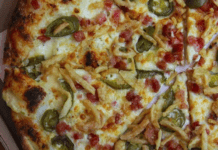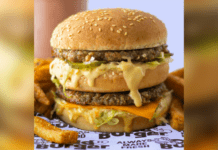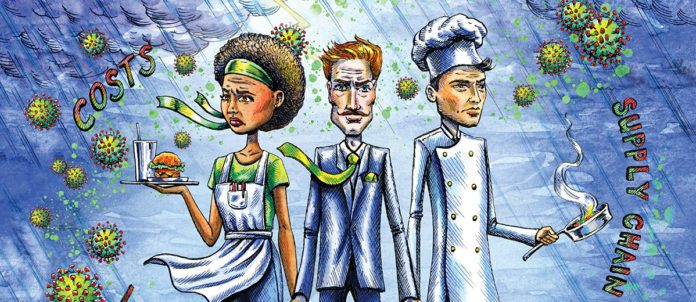Shrouded in pandemic from tip to tail, 2021 — which nonetheless played host to some remarkable successes for Canada’s restaurant industry — challenges anyone describing it to resist quoting Dickens. The best and worst of times were, after all, endured and enjoyed by restaurant players over the past 12 months.
For the industry as a whole, says Vince Sgabellone, industry analyst, Canada Foodservice at NPD Group, 2021, especially the first half, was spent trying to survive in a re-written landscape of government subsidies and new modes of delivery, takeout and meal kits. By June, the switch flipped. Restaurants started re-opening and operators turned to examining what the next phase would look like. People were vaccinated and going out again after months of sheltering at home. Some things were looking pretty good, Sgabellone says. “But there were still 18 months of disaster to overcome.”
From July to September, restaurant visits were down four to six points across Canada — an improvement over April 2020, when they were minus 40 but still a blow. “We’ve come a long way,” says Sgabellone, “but we haven’t recovered. We’re in recovery mode now as opposed to survival mode.”
“Just because restaurants are open and busy doesn’t mean they’re making money,” Sgabellone continues. “It’s great to have bums in seats, but it’s costing more to service those customers now.” Not to mention many restaurants, playing a notoriously low-margin game, have taken on debt in the last stretch. More than 80 per cent of independent restaurants took on pandemic-related debt, says data from Restaurants Canada. At the year’s mid-point, 60 per cent of full-service restaurants were operating at a loss.
The NPD Group is forecasting that the industry isn’t going to return to 2019 levels of traffic until 2023. Some players will recover quicker than others, says Sgabellone. “Any foodservice operation that depends on any kind of hub — transit, entertainment, work — is struggling, and this will continue.”
When the industry went off premises, the operators that were able to service those visits did relatively well. Those with a delivery and drive-thru infrastructure fell the least and bounced back the quickest, says Sgabellone. Drive-thru traffic in 2021 jumped 38 per cent over 2019. And SkiptheDishes saw a 32-per-cent increase in restaurant partners across the network, as well as a 10-per-cent increase in the number of cities and towns it operates in in 2021.
When the calendar flipped to 2021, the country was still very much in the grip of COVID-19 and its attendant side effects, including lockdowns and staffing issues. But while there were pandemic restrictions of one kind or another in most jurisdictions for almost the entire year, there were also supports in place — subsidizing rent and labour, in some cases to a massive extent — that really helped. So, despite reduced sales, a restaurant had the ability to generate revenue in this unprecedented period: it could establish an off-premises program, open a drive-thru, introduce or boost delivery efforts, and so on. As such, says Jeff Dover, a principal with fsSTRATEGY Inc. in Toronto, “a lot were more profitable than they may have been. They made less revenue, but profits were higher for many restaurants.”
Limited-service (fast-food, takeout, delivery) brands and operations performed significantly better than those that relied on the full-service model, though some FSR operators — those whose menus lent themselves to delivery — did okay servicing customers wanting to eat something other than a fast-food burger.
“In the last 12 or 14 months, this has been an uneven recovery,” says Chris Elliott, senior economist with Restaurants Canada. On the one hand, QSRs and caterers are improving, but FSRs and drinking places (bars, taverns, nightclubs) are still on the decline (falling a forecast 22 per cent in the third quarter, and 25 per cent in the last). In August of 2021, foodservice sales for QSR and FSRs had returned to pre-pandemic levels, but “my guess,” says Elliott, “is they haven’t stayed there.”
Overall, the industry suffered about an eight-per-cent decline in 2021 over 2019. In the first quarter, food sales were down about 27 per cent compared to Q1 of 2019, and down 25 per cent in the second quarter. For Q3 and Q4 (projected in the absence of numbers), the situation improved thanks to patio sales (in August, FSR sales were back to pre-pandemic levels, though sales had been down about 50 per cent in May when we were in third wave and there were dining restrictions pretty much across the country).
So, while sales — only one indicator of the health of the foodservice industry — are up compared to what they were before (thanks to delivery, takeout and higher prices), traffic remains well below pre-pandemic levels. Sales should return to pre-pandemic levels in 2022, says Elliott, but traffic not till 2023 or later, depending on tourism and remote-work trends.
The QSR Piece
“I would hesitate to call anyone a winner because the pandemic has taken such a toll on everyone,” says Elliott, “but certainly QSR outperformed the rest of the industry — largely because they could rely on takeout and drive-thru [which at one point accounted for about 50-per-cent of sales at QSRs]. Our surveys found that people felt safe with any kind of takeout, and especially with drive-thru.”
Sales at QSRs were down four per cent to 10 per cent in 2021 over 2019, but reached pre-pandemic levels in July and August. “QSRs are kind of pandemic proof,” says Mark Wilson, president of Toronto-based Culinary Consulting Inc.
“There’s no real data on that topic, but takeout/delivery was the winner [during COVID],” says Jacob Mancini, AVP, Restaurants & Breweries, CWB Franchise Finance, Canadian Western Bank. “It’s blown up. Some of the larger fast-food brands were barely off at all, performing at or close to pre-pandemic levels, particularly in suburban markets. They relied heavily on takeout and delivery and were well positioned to benefit.”
The explanation is simple, says Dover: consumers’ eating-out habits shifted during the pandemic from table service to takeout and delivery. When lockdowns, physical restrictions and general virus uneasiness kept diners out of restaurant dining-rooms, they spent their money on quick-service meals. And many who had not conventionally played in this arena entered it over the last two years with innovative adjustments to their offerings so they, too, could get in on the restaurant-food-at-home trend.
“Generally, QSR thrived in the pandemic,” says Wilson. “Historically, when times are bad, the perceived-value places do well. You’re not necessarily going to go to [Blue Blood] but you might go to Burger King because they’ve got a $6.99 meal.”
But the latter part of the year saw more complications added to the scene in the form of vaccine passports and the necessary role restaurants had to play in enforcing them. And on the heels of this unprecedented novelty comes fresh trials with supply chains. “The year’s been tough from start to finish,” says David Hopkins, president of hospitality consulting agency The Fifteen Group. “But the causes of the toughness have changed over the course of it.”
Those FSRs that have struggled, says Mancini, have struggled significantly. “I don’t know of any full-service operators that are at or near their pre-pandemic levels.” The restrictions on dining made that impossible, he says.
“High-end is the biggest loser, no question,” says Dover, though he concedes that those FSRs with third-party delivery or that were able to adapt to curbside pickup fared better than they might have — though such extensions were never natural to the breed. “Fine dining does not lend itself well to off-premise. I don’t know if I would do a steak off-premise; the longer it’s off the grill, the less attractive it is.”
Still, FSRs were back to pre-pandemic levels, briefly, in August, when people were crowding patios in the warm weather and under a scattering cloud of capacity restrictions. “People felt comfortable eating on a patio; it’s when you start to shift indoors you have hesitation,” Elliott says. “There are some that are still anxious about it. It’s going to take time before people are fully confident.”
A lot of FSR operators got creative with simplifying their menus for delivery, improving their patios to re-kindle consumers’ love affair with outdoor dining, and trying to devise new revenue channels, including adding grocery and bottle shops. “I wouldn’t say it’s a big engine — I don’t think anybody blew the doors off with that,” says Mancini. “But it was another channel to demonstrate creativity and that maybe differentiated you.”
The breakfast segment, which had been on the ascent, had precious few customers during 2021. Dover calls them the pandemic’s “biggest losers.”
But he hastens to point out that the fine-dining segment has been challenged in recent years, still struggling from the last recession. Broadly speaking, he urges that, before getting too dire in their assessment of 2021 for restaurants, we remember where we were before COVID got its claws into us. “If we go back pre-pandemic, the number of restaurant visits have been pretty flat in Canada for years.”
Where a restaurant is situated was also meaningful to its 2021 performance, with those in urban cores getting pinched the most thanks to corporate employment shifting from downtown office towers to the living rooms of the employees who had formerly populated them. By some accounts, the office space in Toronto’s core was only up to about 25-per-cent occupancy at the close of the year.
All told, some 4,500 Canadian restaurants — or about nine per cent — shuttered permanently in 2021, according to the NPD Group/ReCount 2020 restaurant census. That’s versus net 1,000 to 2,000 in a typical year.
Indeed, with so many retail storefronts closing over the last 12 to 18 months, there’s all of a sudden space in the retail market. The days of the little guy getting cut out of good locations have ended with this surfeit of available space. “It could be a boon for these smaller and mid-sized chains who didn’t have opportunities pre-pandemic,” says Sgabellone.
The HMR Piece
Home-meal replacements have been an emerging force for some time, COVID-19’s influence notwithstanding. “As a society, we have less patience and want things faster and easier,” says Hopkins. With COVID-19’s influence, and with HMR already coming into its own in 2019, this trend will continue to do well, he predicts — a brighter outlook than he foresees for delivery and ghost kitchens, both of which he believes will shrink as customers return to restaurants, leaving lots of operators who revved these engines in 2021 in neutral.
Restaurants Canada has identified that about 18 to 20 per cent of restaurants that had no stock in the HMR trade before the pandemic decided to start selling meal kits or groceries over its course and, says Elliott, in a lot of cases, they sold better than expected. “Prior to the pandemic, a lot of grocery stores were starting to look like restaurants. The pandemic swung that pendulum in the other direction and we started seeing restaurants look more like grocery stores.” That’s a permanent change, he says. “Restaurants are finding success in these meal kits and groceries — they’re another revenue stream for them.”
“Home-meal replacements have done really well because they’ve met the need of the marketplace,” sums up Wilson. They’re expensive, he admits, but not so much if you do the math, including the incalculable convenience of not having to shop or meal plan.
The Labour Problem
“I’ve been in the foodservice industry for 40 years,” says Dover, “and I never remember a time we weren’t talking about labour challenges. But this is the most significant I’ve ever seen.”
Most restaurants not set up for takeout and delivery, he adds, laid off a majority of their staff, maybe shrinking the operation to takeout only, overseen by just two or three people, perhaps in the evenings only, five days a week.
Employment in the foodservices-and-accommodation sector is still down more than 200,000 jobs from what it was before the pandemic, according to Statistics Canada. But the low employment is not only a function of businesses struggling under lockdown, it’s also because workers haven’t returned to jobs they held before the pandemic. The number of job vacancies — advertised positions that businesses can’t fill — hit nearly 160,000 in August.
The pandemic revealed cracks in the restaurant labour model and, for the first time in a generation, the balance of power in this industry has shifted in favour of workers. Wage growth has been particularly high in the hospitality, leisure, retail and transportation sectors, says the International Monetary Fund’s 2021 World Economic Outlook. Ontario’s recent increase of the minimum wage, from $14.35 to $15, is just one case in point.
The Supply-Chain Problem
The much-referenced and still misunderstood supply chain is a problem for the recovering restaurant industry because production (of everything) got slowed down during the pandemic and now that everything’s re-opening, it can’t ramp up quickly enough. That’s at least partly why food prices have shot up (beef prices by 13 per cent, pork by 9.5 per cent, cooking oil by 21.5 per cent). That they have, alongside rising labour costs, explains why more than half of owners told Restaurants Canada they are raising prices — about four per cent in 2021 (compared with 2.2 per cent in 2020 and 2.7 per cent in 2019).
“Most restaurants have put their prices up, many by 15 or 20 per cent,” says Hopkins, “and they’re still busy.” The Fifteen Group recently surveyed consumers on the issue and about 70 per cent said they’d be fine with a five to 10-per-cent price increase at restaurants. “Right now, consumers are accepting of restaurants raising their prices,” says Dover. “If you haven’t raised yours, do it now because people are going to be less forgiving as time goes on.”
And the price surge, insists Hopkins. “is something that needed to happen regardless.” Pre-pandemic, he explains, restaurants weren’t overly profitable largely because of competition. Now with restaurants increasing prices beyond what’s necessary to meet increased costs, profits should bump in turn. “And hopefully it stays that way, even when labour and supply issues get resolved, which could take six months to a year. I hope this is a new normal for prices and that, over the next year, the consumer gets used to them and the industry becomes more profitable.”
The 2022 Question
The past year has been one of upheaval and disappointment, resiliency and innovation. It’s been a year of booming takeout and delivery, the spirited rise of ghost kitchens, shifting employment, ballooning costs, failing restaurants and broken dreams. And the scene has yet to settle.
The NPD Group reports that the commercial-foodservice industry lost 1.8 billion visits in the first 12 months of the pandemic, and only about a third of this had returned by the end of August.
“We are in recovery mode,” says Elliott. “But there’s still lots of recovery to go.”
How that will play out is anyone’s guess. “All through the pandemic, we’ve talked about [restaurants having to] ‘pivot,’” says Hopkins. “That’s been the word. Restaurants had to pivot to take on delivery or takeout, come up with HMR kits, sell wine as a retail shop, and so on. Now it’s a different kind of pivot because they’re having to adapt to all these other issues” — namely, skyrocketing food and labour costs, rampant labour shortages, growing inflation and a diminution of the Canadian government’s generous rent and wage supports. Then there’s the vaccine mandates, which reduce in-restaurant dining customers.
“It’s a perfect storm,” says Dover, predicting “2022 might be harder than 2021.”
Just the same, he’s bullish for the future. “There’s pent-up demand for getting out and socializing. The [length of] this inflationary period is the wild card; otherwise, I think it would be a banner year. [As it is], it’ll be tough. But we’ll survive.”
Mancini is equally optimistic. But while he believes things will be back to pre-pandemic levels by summer 2022, he urges caution around expectations.
“There’s still more collapse ahead. I don’t believe that just because you made it this far, you’ll survive. If you’re down 60 or 70 per cent, the only reason you’re still open is because of subsidy programs and whatever concessions suppliers gave you,” he says. “Those subsidies will eventually go away and the industry is facing significant headwinds.”
Brands, he believes, will bounce back sooner than independents. They have access to systems, purchasing power and scale that will allow them to keep costs under better control. And consumers’ comfort level around safety and cleanliness at bigger shops might prove meaningful.
What’s amazing, marvels Elliott, is the revealed resiliency of the industry. In 2021, sales overall were down 16 per cent compared to 2019. In 2022, sales are going to be up 4.4 per cent compared to 2019 (compared to 2020, 24.3 per cent).
“Nothing has put the industry at such great risk. And we’re still in a world of incredible uncertainty. Will there be a fifth wave? More shutdowns? But I’m definitely feeling more optimistic about 2022 because vaccinations are working and we’re expecting a continued re-opening of the economy.”
BY LAURA PRATT

















